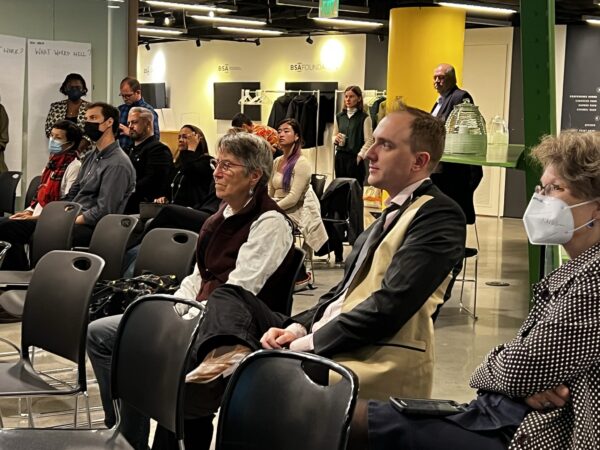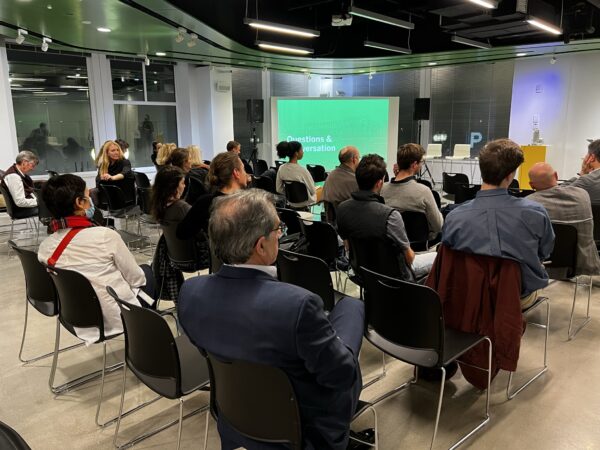BSA Town Hall invites members to engage with next phase of strategy work

On Thursday evening, members of the BSA community gathered at the space for a town hall focused on the organization’s continued work on climate and equity issues.
The event served as a way to update members on the BSA’s strategy work while providing an opportunity for the community to share ideas and connect with one another.
Incoming BSA President Andrea Love AIA kicked off the evening’s activities by welcoming guests and emphasizing the many opportunities that are in store for professionals, who will continue to receive support from the BSA in the form of networking, leadership opportunities, events, and more. Billy Craig Hon. BSA, Managing Director, will lead this aspect of the BSA’s work, building on his extensive experience working with members.
Love then switched gears to focus on the BSA’s expanding innovation work, which launched at the end of last year. Love described the BSA’s goal of producing built environment solutions to the pervasive problems of climate change and inequity, harnessing the expertise of members and staff in collaboration with various stakeholders throughout the community.
“This work will be both transformative and iterative,” said Love. “We know we’re experimenting, and we expect both the process and the work to evolve over time.”
Nigel Jacob, Managing Director of Innovation, introduced the BSA’s innovation work and a process for selecting projects that will guide the BSA’s future innovation work and help to fulfill the organization’s mission. Jacob, co-founder of the Mayor’s Office of New Urban Mechanics, has a background in civic innovation and joined the BSA in September.
“We need more experimentation, more exploration of the kinds of things we should be doing in architecture and in the built environment more generally,” he said.
The process to select projects involves the forthcoming launch of a Request for Innovation. Proposals will be chosen based on how well they fulfill a set of criteria, which includes addressing climate and/or equity in the built environment, having a positive impact on residents, and harnessing the knowledge of architects and designers.
“We hope we’ll be able to target issues of real relevance to our residents and work with them, not around them, and engage them actively,” Jacob said.


The Request for Innovation will go live on November 1st. Afterwards, workshops and “office hours” will be held at the BSA, where participants will have the chance to ask questions, share their ideas, and communicate with BSA staff. Selected projects will be announced in the first quarter of next year.
“This is work that the BSA has been doing for a long time,” Jacob said. To elaborate, he invited Wandy Pascoal, Housing Design Fellow at the BSA, and Donald Wright**, Title Deputy Director, Real Estate Management and Sales at the City of Boston,** to discuss some of the BSA’s ongoing housing innovation work in the form of “Co-Creating Boston’s Future-Decker.”
Tom Chung FAIA, Principal at Leers Weinzapfel Associates, then spoke to the group about opportunities to expand the use of mass timber, a sustainable construction material composed of wood panels. Nicole St. Clair Knoblauch, Principal at Olifant, presented virtually on the BSA’s work with mass timber and its partnership with the city and other organizations through the Mass Timber Accelerator.
Afterwards, attendees embarked on an “idea sprint,” breaking into small groups to discuss the question: “How might the BSA’s work championing innovation in the built environment to address social inequity and climate change best support the work you do?” Attendees were invited to share their ideas with the wider group.
One of the other big changes in store for the BSA is a planned renovation of the space, prompted by the Atlantic Wharf development's repositioning of its publicly accessible facilities. Juann Khoory of West Work, the firm leading the project, gave an overview of the renovation goals and invited attendees to share what they most want to see from a new space.
The evening ended with refreshments and conversation as attendees spent time in a BSA space that will soon look and function differently, while still providing essential services members have come to rely upon and enjoy.

